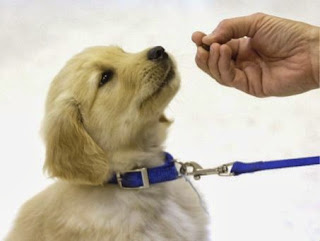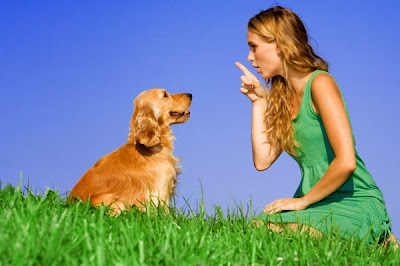Before Starting
Before we begin to do our dog training activity, there are some rules of the game in this training:
* Short.
Do not be too long giving or repeating the training. just 15 minutes 2 times a day for each lesson.
* Simple.
Repeat until dog training materials we understand well, do not proceed to another matter.
Repeat until dog training materials we understand well, do not proceed to another matter.
* Nice.
Make this exercise into an exciting moment for us and dog.
Our 'mood' during the training is as important as the 'mood' of our dog. If we and the dog are not in a good mood, you should postpone the exercises. Remember, the objective is to strengthen our relationship (bonding) with our dog. We are the leaders of them and the doggie must be a faithful follower.
For thousands of years, dog always use their mental and physical. While today's dog always stayed at home and protected from harm. This condition can make dog become bored and ultimately encourage the emergence of problems in behavior. All this can be avoided by training our doggie by a short, simple, and fun to be interwoven relationships (bounding) between us and the dog.
Make this exercise into an exciting moment for us and dog.
Our 'mood' during the training is as important as the 'mood' of our dog. If we and the dog are not in a good mood, you should postpone the exercises. Remember, the objective is to strengthen our relationship (bonding) with our dog. We are the leaders of them and the doggie must be a faithful follower.
For thousands of years, dog always use their mental and physical. While today's dog always stayed at home and protected from harm. This condition can make dog become bored and ultimately encourage the emergence of problems in behavior. All this can be avoided by training our doggie by a short, simple, and fun to be interwoven relationships (bounding) between us and the dog.
Personality Type
Although the breed or breeds of dogs already have a personality profile of each, but ultimately every dog has a unique personality. Some dogs are extroverts and love to be center of attention, while the other is more submissive. Both types of dog can be trained, but different ways of handling. The origins of our dog and what they've done in the past could affect his ability in the training process.
Personality traits
Compromise
Most dogs are not exactly submissive or domineering. Conditions and different owners could lead to different situations. Well, most of the doggie has a mix of submissive or dominate nature. But basically they want to open with their owners to be given lessons.
Manipulation
Lots of dog we really thought they were obedient, but in fact they manipulate their owners. Instance, we have a dog who often scratch / bite our feet with the intention of asking us to hold them. Create from some of us feel this is a sweet (cute), but in fact these dogs have been studying different methods in determining authority.
Coward
Dogs with an attitude of submission (head down) and they avoid eye relationships (with owner), hiding their tails between their legs, and frightened when someone close to them. These dogs require a slow and gentle approach during training, we should not issue orders to rough. For this type, you should ask for help from a professional trainer, if we have not previously been trained dog.
Intruder
Some dogs are more interested in playing with other dogs than their owners obey. Often, the cause is in the puppy less socializing with people (more likely to play at home with other puppies).

Cooperative and willing to listen
This is the easiest doggie to be trained because they have a natural curiosity and want to give attention to their surroundings, especially with humans. Dogs who have this type would be easier to train than the doggie who have other types.
Dominant and confidence
Some dogs, regardless of ancestry, have profiles that are naturally confident. The sex of the dog also affect the trainability. Doggie doggie who has been castrated and females who are not loops are the easiest to train. While males (especially who are in conditions of high lust) tend to be more dominant and confidence, as a result, they may become less willing to listen to instruction training, especially training obey.
Things you need to know before you do the training
Before we start training, you should be prepared treats / snacks as a reward and punishment as a water pistol. Training should be started on an empty stomach dog (so he's more focused on our command, and certainly more hope treat analysis).
Reward and Punishment
Every time doggie we follow what we tell it, give him a treat reward while accompanied by praise "Yes" or "Smart". Meanwhile, if he made a mistake, shoot water Pistor behind ears or on her back while saying "No" or "Bad". If over time the doggie'm used to following orders, then little by little treat / snack is reduced but still give praise in the form of "Yes" or "Smart" was.
Body Language
During training watch doggie body language. If he looks tired or lose concentration, you should stop exercising while. Coaches should also be in a state of 'mood'. show expression and establish eye-contact with the doggie during exercise.
Release Command
In this exercise doggie must be disciplined, but we must also teach the word "Free" or "Done" when we want a doggie to relax or exercise that is also complete.
Things that need to be avoided during the training:
1. Do not give treats to doggie except during exercise.
2. Do not make doggie treats to lure to stop doing something. For example there are doggie who is pursuing a bicycle, we continue to call with food. This means we teach him that the pursuit of a good bike.
3. Do not hit the doggie for any reason during the training.
4. If training with another doggie, doggie should not until we locked eyes with another doggie. because this can lead to fights. divert his eyes with our hands so that no eye-contact.




No comments:
Post a Comment